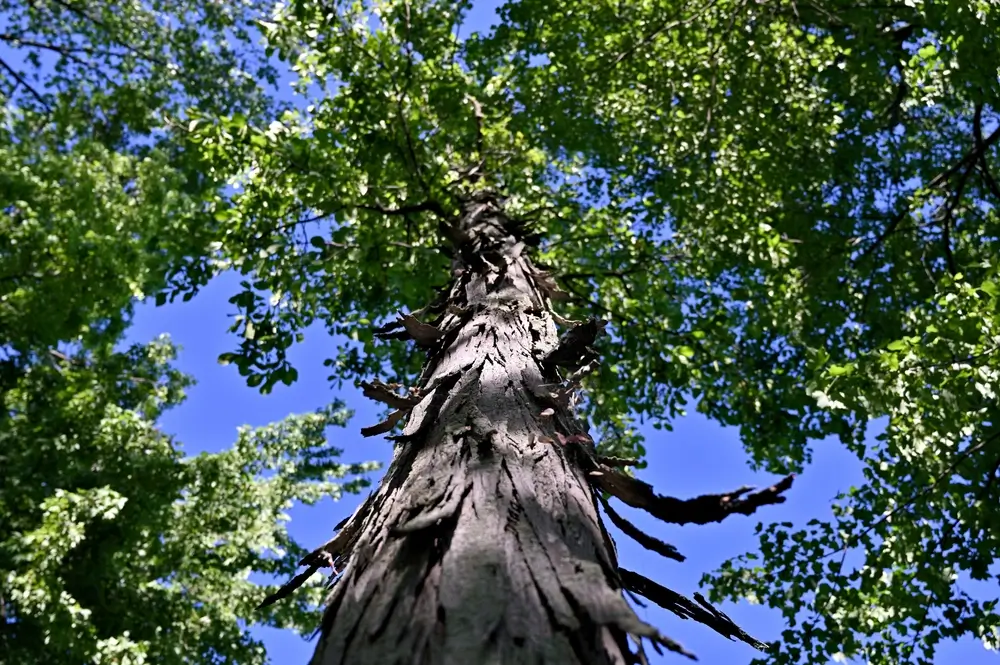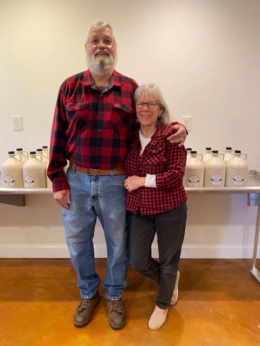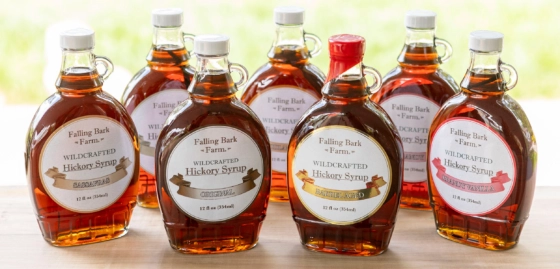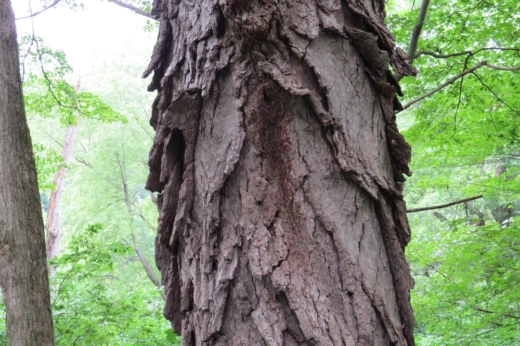Joyce and Travis Miller are two of just a handful of hickory syrup producers in the world today.

Enter just about any American supermarket and you’re bound to find a jug of maple syrup somewhere. Hickory syrup? Not so much. Maples and hickories make up a small fraction of the approximately 1,000 native North American tree species, but only the former is well represented within our modern regional food culture, despite the fact that something flavorful and nutritious can be harvested from many of these native trees.
Joyce and Travis Miller had long lived among hickories in the woods of Clarke County, Virginia and had retired from their careers before ever tasting hickory syrup. Twelve years since then, they’ve founded their own operation, Falling Bark Farm, and are two of just a few hickory syrup producers in the world today.
This later-in-life endeavor was a natural next chapter for the Millers, who had always been interested in feeding themselves from the land through gardening, hunting and foraging. Travis had worked in the grocery business for 30 years, as well as in a reclaimed lumber facility, so it wasn’t a huge leap to making food from trees.
In 2011, having just entered retirement but looking for a way to keep busy and keep earning some kind of income, Travis and Joyce asked themselves: “What could we take to the farmers market?”

Joyce and Travis Miller. (Photo courtesy of Falling Bark Farm)
They had heard from a neighbor about hickory syrup and, given their proximity to many hickory trees, decided to give it a go. The Millers ordered 48 empty glass bottles and began researching the syrup-making process, which has roots in Native American culinary and medicinal practices. (Hickory bark is extraordinarily high in magnesium and has been historically used as a health supplement.)
“When we started out, we would go into the woods ourselves to harvest bark,” says Travis. Unlike with maple syrup, where a hole is drilled into a maple tree to extract its sap, hickory syrup is made with the bark of a shagbark hickory tree that is collected after it has fallen to the ground. No harm is done to the tree.
To make the syrup, the Millers scrub the harvested bark clean, then toast it on an open flame grill to enhance the flavor. Next, they simmer the bark in water on their home kitchen stovetop to make a hickory extract. This is combined with turbinado sugar and, as with the making of maple syrup, a hydrometer is used to test the syrup’s density and determine its sweetness.
No additives, thickeners or dyes of any kind are added. Falling Bark Farm does, however, offer some naturally flavored hickory syrups, including a syrup infused with whole vanilla beans, another aged in bourbon barrels borrowed from a nearby distillery and a “Woodland Spice” variety made with cinnamon, cardamom, clove and allspice that is especially popular around the winter holidays.
“We’re bottling one at a time and everything’s done by hand,” says Travis, explaining that he and Joyce continue to do everything themselves, even as the business has grown to approximately 3,000 gallons of syrup a year. “It’s a little crazy at times, but we’re holding it together.”

The Millers bottle their hickory syrup by hand. (Photo courtesy of Falling Bark Farm)
While the Millers still sell their hickory syrup in person at about a half dozen events annually, after their first year as vendors at local farmers markets, they’ve focused primarily on sales through their website and local businesses.
“The type of product we have is not like a loaf of bread where you consume it during the week or a bottle of wine that might be shared and finished in a single sitting. After four or five weeks at a farmers market, you’ve reached the regular attendees and then the consumer needs time to use the product,” explains Travis. “We got into doing selective private labeling for significant historical locations, like Monticello and Mount Vernon. That’s been a big bonus for us because it also taps into tourism, not just local consumers.”
Demand for Falling Bark Farm’s hickory syrup has grown to the point that the Millers are no longer harvesting their own bark from just around their land. “Some of our bark comes from the timber industry, where the log has been harvested and, at that point, there isn’t any value to the bark,” says Travis. “We’re taking a waste product and turning it into something that people enjoy.”
In this way, the Millers are a midway point in a sustainable system that honors all that the hickory bark has to offer. After they have made syrup, they pass along the bark to a local barbecue business that uses it to prepare the smoked foods on their menu.

The tree’s bark is collected after it has fallen to the ground. (Photo: Shutterstock)
Falling Bark Farm’s hickory syrup itself has found its way onto the menus of many restaurants throughout Virginia and surrounding states, becoming a star ingredient in a broad range of dishes and drinks. With its golden-brown color and thick, slow-pour consistency, hickory syrup is similar in appearance to maple syrup and can also be used as a sweetener in foods and beverages, but it has an aroma and flavor all its own that is slightly smoky and earthy with a hint of molasses.
The Millers have been surprised by the diversity of dishes and drinks that customers and clients have prepared with their hickory syrup—everything from savory meals of grilled salmon and roasted lamb shanks to side dishes of baked apples and cast iron skillet grits with ramps to craft cocktails and beers—and by the community that has flourished along with their business.
“One of the best things about making the syrup has been all of the people that we’ve met,” says Joyce. “We’ve been overwhelmed with kindness.”
Loved this article. Sounds like a neat product, this hickory syrup.
It’s a lovely story, but the way this “hickory syrup” is described and compared to maple syrup seems confusing. The article says that “no additives…of any kind are added” yet describes adding cane sugar. Is this where all the sugars in the product come from? How then is “hickory syrup” not just hickory-bark-flavored sugar syrup? Tasty, I’m sure, perhaps also rich in magnesium, but a far cry from maple or other syrups made from the sugars already in the sap/juice of the plant itself, where literally nothing is added. It certainly seems disingenuous (if not outright inaccurate) to say it’s… Read more »
I agree with thee other comment about “no additives” when earlier in the article it states that turbinado sugar is added. Am I missing something here?